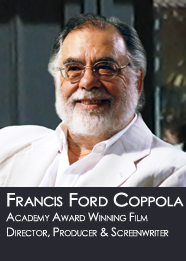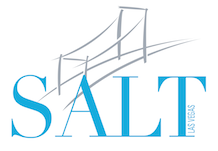CONFERENCE SPEAKERS
Francis Ford Coppola
Academy Award Winning Film Director, Producer & Screenwriter
Francis Ford Coppola is one of the most influential and innovative filmmakers of our time. As the maverick founder of his company American Zoetrope, he personally initiated and nourished the careers of talents such as George Lucas, Carroll Ballard, John Milius, his daughter, Sofia Coppola, and actors including Al Pacino, Robert DeNiro, James Caan, Harrison Ford, Richard Dreyfus, Diane Keaton, Robert Duvall, Laurence Fishburne, Matt Dillon, and Diane Lane. Zoetrope-produced films have received sixteen Academy Awards and seventy nominations. As a writer, director, producer, and technological pioneer, Francis Coppola has created a body of work that has helped to shape contemporary American cinema.
Born April 7, 1939 in Detroit, Coppola is descended from musically-gifted Southern Italians who immigrated to New York in the early 20th century. His maternal grandfather, Francesco Pennino, was a songwriter, and his father, Carmine, first flute for the NBC Symphony under Toscanini. He himself might have gone on to a career in music were it not for a bout of polio when he was nine, which kept him paralyzed for well over a year. During his confinement, he developed an interest in puppetry and ventriloquism, and started making 8mm movies when he was back on his feet. After graduating in 1959 from Hofstra College with a B.A. in Theatre Arts, he enrolled at UCLA for graduate work in film.
In 1962, Coppola's student screenplay Pilma Pilma won the Samuel Goldwyn Award at UCLA, after which he began his professional career in earnest. His adaptations of Reflections in a Golden Eye, This Property Is Condemned, and Is Paris Burning? were produced, making him a much-in-demand screenwriter. He also wrote a script about George Patton, and in 1970, Patton won 7 Academy Awards including Best Picture and Best Adapted Screenplay, shared by Coppola with co-writer Edmund H. North.
Coppola second film, You're a Big Boy Now (1966), marked his first appearance at the Cannes Film Festival, where he would later enjoy acclaim, twice winning the Palme d'Or (The Conversation, 1972; Apocalypse Now, 1979). He directed Fred Astaire in Finian's Rainbow, adapted from the Broadway musical, followed by an original work, The Rain People. Coppola's ability to make The Rain People with a minimum of studio interference, inspired him to establish, along with his friend George Lucas, American Zoetrope, a San Francisco-based production center for young independent filmmakers. Lucas's first two features, THX 1138 (1971) and American Graffiti (1973) were produced under its aegis. But the company was high maintenance, and in 1970 Coppola was persuaded to direct a gangster picture based upon a best-selling novel by Mario Puzo, The Godfather. The Godfather created a sensation upon release, altering the course of his career, along with its equally successful follow-up, The Godfather, Part II. In between the two gangster epics, Coppola made The Conversation (1974) from his original screenplay, a thriller about wiretapping and responsibility which endures as one of his most admired and influential pictures.
In 1976, Coppola began Apocalypse Now, financing the Vietnam War epic himself. Almost everything that could go wrong did: star Martin Sheen suffered a heart attack; co-star Marlon Brando showed up grotesquely overweight; a typhoon destroyed the sets. Shooting stopped, then re-started, and the budget skyrocketed, delaying the film's release until 1979. Stylistically, Apocalypse Now was so unusual, especially for a war film, that critics were originally divided. Nonetheless, its box office was over time hugely successful. Apocalypse Now has come to be regarded as a masterpiece, influencing generations of directors across the globe.
The 1980s brought about a radical change in Coppola's career. Desiring to create an electronically modern filmmaking facility, he bought Hollywood General Studios and renamed it "Zoetrope Studios." Production immediately began on Hammett, directed by Wim Wenders, and soon thereafter on One From the Heart, a musical. Some of the innovations that came out of this period were "previsualization" (a phrase coined by Coppola), use of ethernet as a means of departments communicating, word processing for screenplays (which garnered much suspicion from the Writers Guild who thought that a computer was actually writing the scripts), re-introduction of video assist, the development of 5.1 stereo sound, electronic editing, and experimentation with high-definition. But cost overruns incited an avalanche of negative publicity which deleteriously affected reception to the films. Ownership of the facility passed into the hands of creditors, and Coppola returned to Northern California.
The 1980s constituted a period of 'work for hire,' as Coppola labored to pay off the banks that had financed his failed Hollywood studio. He made a film nearly every year, taking what jobs were offered to him, but always putting his personal creative stamp on the films. As a new decade commenced, Coppola was in the spotlight once again: The Godfather, Part III (1990) garnered 7 Oscar nominations, including Best Director. Bram Stoker's Dracula (1992) snared 3 Academy Awards. The Rainmaker, starring Matt Damon, introduced him to a new generation of actors, but in Coppola's mind, his career of 'work for hire' had come to an end.
Coppola was perplexed and uncertain of direction until, in 2005, he was reminded of low-budget filmmaking by his daughter Sofia's film Lost in Translation. He decided to return to the desire of his youth; to write and direct small personal films in the manner in which he had made The Rain People. He had read Youth Without Youth, a story by Romanian philosopher Mircea Eliade, an allegory about an aging professor who becomes young again. His spirits soared. "I can make this," he thought. He packed a van full of equipment, shipped it to Romania and made the film. He followed that with his most personal film to date, Tetro, shot in the same way, with a few vans and a small crew, in Argentina.
Francis Ford Coppola has always been a dreamer, but he is one of those rare people who determinedly has turned his dreams into reality. His dreams and interests have not only have involved cinema, but have encompassed literature, wine, and travel as well.
In 1997, Coppola launched Zoetrope: All-Story, a quarterly magazine of short fiction. Each issue was guest-designed by a leading artist, from musicians (David Bowie, PJ Harvey) to filmmakers (Dennis Hopper, Wim Wenders), performers (Mikhail Baryshnikov) to fine artists (Kiki Smith, Julian Schnabel). It won every major story award, including a National Magazine Award for Fiction, publishing the greatest writers of our time alongside new and emerging talent.
In 1975, Francis and Eleanor Coppola purchased part of the historic Inglenook wine estate in Napa Valley, including 1400 acres of land and founder Gustave Niebaum's house. In 1978 the Estate produced the first vintage of Rubicon wine, a blend of Cabernet Sauvignon, Merlot and Cabernet Franc. In 1995, the Coppolas purchased the remaining part of the original property, which included the Inglenook Chateau and approximately 90 acres of vineyards. The Coppolas restored the Chateau and grounds to grandeur, making it one of the most popular visitor destinations in the Napa Valley. In 2006, Coppola renamed the property Rubicon Estate, after its flagship wine. "Our goal has always been to make one of America's great wines," said Coppola. "You don't get involved with an Estate like this, without that as your goal."
Coppola subsequently acquired a winery in Geyserville, Sonoma Valley, in 2008. He worked with his longtime art director, Dean Tavoularis, to re-design the existing property, and inspired by Tivoli Gardens in Denmark, created a spectacular property which now includes a restaurant, cinema museum, swimming pools, and bocce courts. The renovation is expected to be completed in October 2010.
In the early 1980s Francis Coppola visited the new democracy of Belize (formerly British Honduras) with the hope of convincing the government to establish a satellite address and become a hub of communications. The government demurred, but Coppola fell in love with Belize, and in the process purchased a mountain lodge called Blancaneaux. In 1993, Coppola opened his jungle paradise to the public. Ten years later, he established its beach companion, Turtle Inn. Then he discovered La Lancha Resort, on the shores of Lago Peten Itza in Guatemala. The three properties offer an amazing array of exotic and luxurious accommodations, and diverse nature and cultural adventures, and regularly appear on the 'Best Resorts' lists of travel magazines.
Francis Coppola's philosophy when choosing a location for his resorts has always been that if he enjoys it, others will too. After living and working for a year in Buenos Aires, Argentina, he bought a large house and converted it into a boutique hotel, Jardin Escondido. His current project is very close to his heart. Palazzo Margherita is a large palazzo or mansion in the Italian town of Bernalda, where Coppola's paternal grandfather was born. It is presently undergoing a complete renovation and will be a small boutique hotel in the beautiful Basilicata region of Southern Italy. It is projected to open in the summer of 2011.


